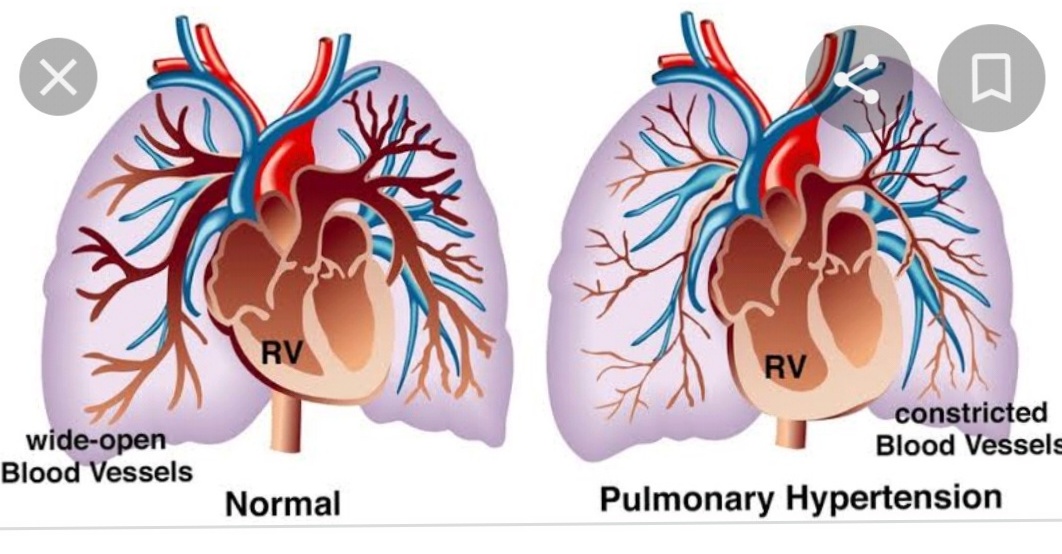“Lung Cancer Symptoms: Warning Signs You Need to Know”
Summary
The genesis of lung cancer is the proliferation of cells in the lungs. The chest contains the two sponge-like lungs, which regulate breathing.
The main cause of cancer fatalities worldwide is lung cancer.
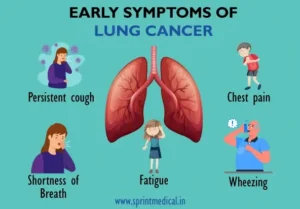

The individuals most at risk for lung cancer are smokers. The risk of lung cancer rises with the amount of cigarettes smoked and the length of time. The likelihood of developing lung cancer is greatly reduced by stopping smoking, even if you have been doing so for a long time. It’s possible for nonsmokers to develop lung cancer as well.
Symptoms of lung cancer may be subtle and readily confused with those of other diseases, making early diagnosis difficult. A persistent cough, chest pain, shortness of breath, coughing up blood, and unexplained weight loss are a few of the typical symptoms. Additional possible signs are exhaustion, frequent lung infections, a raspy voice, and wheezing. If you have any of these symptoms, it’s essential to see a doctor, especially if they don’t go away or get worse over time.
Common Symptoms:


- Persistent Cough: A cough that doesn’t improve or gets worse over time, particularly if it’s accompanied by additional signs like coughing up blood.
- Chest Pain: Discomfort in the chest that might be exacerbated by laughing, coughing, or taking big breaths.
- Dyspnea is defined as having trouble breathing or feeling breathless even when doing ordinary tasks.
- Coughing Up Blood: This might vary from a little bit of blood to a lot.
- Unexplained Weight Loss: A considerable amount of weight loss that occurs for no apparent reason.
- Fatigue: Feeling extremely weary or feeble.
- Recurring Lung Infections: Repeated occurrences of bronchitis or pneumonia.
- Wheezing: A whistling sound when breathing, particularly when exhaling.
- Hoarseness: A shift in the sound of your voice, such as a raspy or tight tone.
- Loss of Appetite: A reduction in appetite or a sense of early fullness.
- The neck and face may become swollen as a result of lung cancer, particularly in its later stages.
- Finger Clubbing: Widening and rounding of the fingertips and nailbeds.
Fewer Typical Signs:
Bone Pain:
Pain, particularly in the back or hips, can result from the spread of lung cancer to the bones.
Neurological Indicators:
Lung cancer can sometimes damage the neurological system, resulting in symptoms such as disorientation, seizures, or paralysis.
Paraneoplastic disorders:
In rare cases, lung cancer can cause the immune system to attack other areas of the body, resulting in disorders such as Lambert-Eaton syndrome (muscle weakness) or paraneoplastic cerebellar degeneration (loss of coordination).
Key Factors to Consider:
- Early Detection is Key: Lung cancer is more treatable when diagnosed in its early stages.
- Symptoms May Vary: In the beginning, some people with lung cancer may not have any symptoms, while others may have a wide range of symptoms.
- Visit a Doctor: It’s crucial to visit a doctor for diagnosis and appropriate treatment if you have any of the symptoms listed above, particularly if they continue or get worse.
When to consult a physician
Schedule a visit with your doctor or another healthcare practitioner if you have any symptoms that concern you.
Make an appointment if you smoke and have been unable to stop. Your medical practitioner can advise you on ways to give up smoking. Nicotine replacement therapy, medication, and counseling may be among these.
Causes
Cells in the lungs undergo DNA alterations, resulting in lung cancer. The instructions for what a cell should do are stored in its DNA. The DNA dictates the rate at which healthy cells divide and proliferate. The cells are instructed to die at a specific moment in the instructions. The DNA modifications in cancer cells provide alternative instructions. The alterations instruct the cancer cells to proliferate more quickly. Cancer cells can survive while healthy cells would perish. This results in an excessive number of cells.
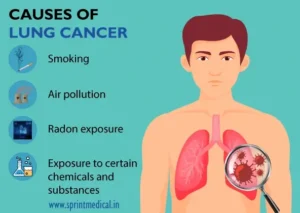

Tumor is the term for a mass that cancer cells can create. The tumor may grow to invade and kill healthy tissue in the body. Cancer cells may eventually break away and spread throughout the body. Metastatic cancer is the term for when cancer spreads.
The majority of lung cancers are brought on by smoking. It can lead to lung cancer in both smokers and those who are exposed to secondhand smoke. However, lung cancer can also occur in individuals who have never smoked or been around secondhand smoke. It’s possible that the reason for lung cancer in these individuals is unclear.
The mechanism by which smoking contributes to lung cancer
Researchers think that smoking increases the risk of lung cancer by harming the cells that make up the lungs. Carcinogens are the cancer-causing chemicals that make up cigarette smoke. The carcinogens in cigarette smoke alter lung tissue almost instantly upon inhalation.
Your body may be able to fix this harm at first. However, repeated exposure results in increased damage to the healthy cells lining your lungs. The harm leads to cell modifications over time, which might eventually result in cancer.
Lung cancer types
Based on the appearance of the cells under a microscope, lung cancer is classified into two main types. The treatment choices made by your healthcare provider are determined by the primary kind of lung cancer you have.
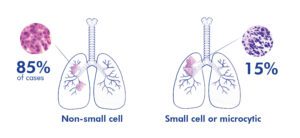

Lung cancer can be broadly divided into two categories:
minor cell lung cancer. People who have smoked a lot for many years are often the only ones who get small cell lung cancer. Non-small cell lung cancer is more prevalent than small cell lung cancer.
Lung cancer that isn’t small cell. There are many different forms of lung cancer included under the umbrella term “non-small cell lung cancer.” Squamous cell carcinoma, adenocarcinoma, and large cell carcinoma are all examples of non-small cell lung malignancies.
Risk factors
There are a variety of things that might make you more at risk for lung cancer. Quitting smoking is an example of a risk factor that may be managed. Your family history is one of the things you can’t control.
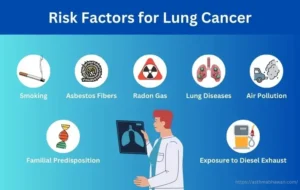

The following are some risk factors for lung cancer:
Smoking
The amount of cigarettes you smoke each day raises your risk of developing lung cancer. Additionally, the amount of years you have been smoking raises your risk. Your risk of lung cancer may be greatly reduced by quitting at any age.
secondhand smoke exposure
Being in the presence of smokers raises your chance of getting lung cancer, even if you don’t smoke. Secondhand smoke is when you breathe the smoke that other people produce.
Previous radiation treatment
You may be more susceptible to lung cancer if you have previously undergone radiation treatment to the chest for a different form of the disease.
Radon gas exposure
The spontaneous decay of uranium in soil, rock, and water results in the production of radon. Ultimately, radon enters the air you breathe. Any structure, including a house, may have hazardous radon levels.
exposure to carcinogens
Your risk of lung cancer may rise if you are exposed to carcinogens at work. If you smoke, the risk could be greater. Among the carcinogens associated with the risk of lung cancer are asbestos, arsenic, chromium, and nickel.
Lung cancer runs in the family
An individual’s risk of developing lung cancer is higher if they have a father, sibling, or kid who has the illness.
Problems
Among the potential complications of lung cancer are:
Breathlessness
If lung cancer spreads to the point where it obstructs the main airways, patients may have shortness of breath. Fluid can accumulate around the lungs and heart as a result of lung cancer. When you breathe in, the fluid makes it more difficult for the afflicted lung to expand completely.
Bringing up blood
Bleeding in the airway can be brought on by lung cancer. This may cause you to cough up blood. Bleeding might occasionally be quite bad. Bleeding can be managed with available treatments.
Pain
Advanced lung cancer that spreads might be painful. It could spread to a bone or the lining of a lung. Inform your doctor if you are experiencing pain. There are several pain management options.
The presence of fluid in the chest
Pleural effusion, which is the buildup of fluid in the chest, can be brought on by lung cancer. The pleural space, which is the area in the thoracic cavity that surrounds the diseased lung, is where the fluid accumulates.
A pleural effusion can cause shortness of breath. There are therapies that can help drain the fluid out of your chest. The likelihood of recurrence of pleural effusion can be reduced by treatments.
Cancer that spreads to other parts of the body
Lung cancer frequently metastasizes to other areas of the body. The brain and bones are two potential locations for the spread of lung cancer.
The symptoms of cancer that spreads might include headaches, nausea, pain, or other symptoms depending on the organ that is impacted. Lung cancer is often not curable after it has spread outside of the lungs. There are treatments to lessen symptoms and extend life expectancy.
Avoidance
While there is no foolproof method to prevent lung cancer, you may lower your risk by doing the following:
Avoid smoking.
If you have never smoked, do not begin. Speak to your children about abstaining from smoking so they may learn how to prevent this significant risk factor for lung cancer. Start talking to your kids about the risks of smoking as soon as possible, so they will be prepared to handle peer pressure.
Quit smoking
Quit smoking right now. Even if you’ve been smoking for a while, quitting will lower your chance of getting lung cancer. Discuss strategies and aids that might help you quit with your healthcare team. Nicotine replacement therapy, drugs, and support groups are some of the available options.
Stay away from secondhand smoke
Encourage those who smoke, whether they live with you or work with you, to stop. At the very least, ask them to smoke outside. Stay away from places where people smoke, like bars. Look for smoke-free choices.
Check for radon in your house.
Have the radon levels in your house tested, particularly if you live in a place where radon is known to be an issue. Your house may be made safer by lowering high radon levels. Radon test kits are available online and at hardware stores. Contact your local health department for additional details about radon testing.
Stay away from workplace carcinogens
Be careful to avoid exposure to harmful chemicals at work. Follow your employer’s guidelines. Wear a face mask at all times, for example, if it’s provided to you as protection. Find out from your doctor what else you can do to stay safe at work. Smoking increases your risk of lung injury from carcinogens in the workplace.
Consume a diet rich in fruits and veggies.
Pick a nutritious diet with plenty of fruits and veggies. Vitamins and nutrients are best obtained from food. Refrain from consuming excessive vitamin pills because they might be dangerous. Researchers, for example, gave beta carotene pills to heavy smokers in an attempt to lower their chance of getting lung cancer. According to the findings, taking the supplements raised the chance of cancer in smokers.
Work out the majority of the days of the week
Begin slowly if you aren’t used to working out frequently. Make an effort to workout most days of the week.

